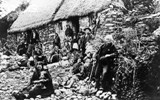Refreshing this from Thomas Sowell’s classic Ethnic America: I am struck by this comparison he makes between the desperate state of the Irish peasantry in Ireland and the black slaves in America:

“A French traveler in the early nineteenth century returned from a trip that included America and Ireland and wrote:
‘I have seen the Indian in his forests and the Negro in his chains, and thought, as I contemplated their pitiable condition, that I saw the very extreme of human wretchedness; but I did not then know the condition of unfortunate Ireland.’”
Sowell continues: “This was not mere rhetoric. Slaves in the United States had a longer life expectancy than peasants in Ireland, ate better, and lived in cabins built of sturdier materials, with more space, ventilation, and privacy, than the huts of contemporary Irish peasants. It is unnecessary to attempt to say who was worse off on net balance. The mere fact that such a comparison could be made indicates something of the desperate poverty of Irish peasants in the 1830s” (p. 18).
Later, Sowell compares the brutality of the slave trade’s Atlantic crossing with that of the Irish migration:

“Inadequate food, water, and sanitation made ocean crossings dangerous to health and life. In the most disastrous year of all, 1847, about 20 percent of the huge famine immigration died en route to America or upon landing. This was about 40,000 dead—mostly young people in the prime of life. By comparison, the loss of life among slaves transported from Africa in British vessels in the nineteenth century was about 9 percent” (p. 22).
Awful.
(The images show a group of Irish peasants and a ship loading plan for African slaves.)
See also my Open College episode “Slavery’s Greatest Enemies.”
to whom did the relative value of the cargoes have significance?
Note the importance of C O D.
Further context:
Whilst the Irish mortality rate was 20% in 1847, it was lower in other years. In this context it’s invidious to compare a worst year with a long term average.
It’s fair to note the 9% mortality rate for the Atlantic crossing. However the mortality rate for cross land journeys inside Africa must be considered.
Setting aside the myth of Kunta Kinte, we know that the vast majority of African slaves were captured in internal wars (and not abducted by white slavers). That incurred death and suffering, subsequent to which many more died crossing Africa to the place of sale. That’s a hard estimate but we do know:
While the mortality rate for slaves being transported across the Atlantic was as high as 10%, the percentage of slaves dying in transit in the Trans Sahara and East African slave trade was between 80 and 90%!
source
Not that I’m dismissing Sowell’s point. It’s often been noted that the condition of the working classes in the early industrial era was shocking compared to the immediate agrarian past.
My great grandfather came to America during the Irish Potato Famine. He left Sligo, Ireland as a stowaway when he was 10 years old. Legend says he jumped ship close to Mobile, Alabama and escaped the grasp of the Captain. He is not on any manifest I know of.
I believe he was very desperate. My trip to Ireland indicates none of his family survived the famine. No record of him until he musters up for the Confederacy of the Civil War. Ancestory research is a dead end.
I wonder of how that must have been in 1847…10 year old stowaway…lower than a slave? Raised by a slave family?
I am about to go to Wilcox Co., Alabama where he married in 1870.
I am planning to read Ethnic America, but any thoughts on that era and an Irish boy who is a stowaway…..I have no idea how to imagine that. Would appreciate a response or a reference.
Thanks,
Tom Colkin
Hello,I read your new stuff named “Irish peasants and black slaves – Stephen Hicks, Ph.D.” like every week.Your story-telling style is witty, keep doing what you’re doing! And you can look our website about proxy list.
Incredible historical context and perspective.